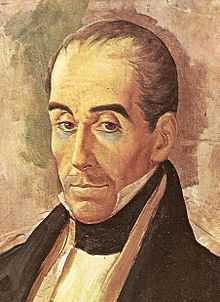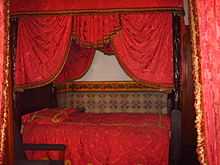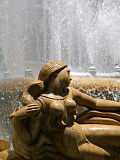Birthplace of Simón Bolívar
| Birthplace of Simón Bolívar | |
|---|---|
| Casa Natal del Libertador Simón Bolívar | |
|
Simón Bolívar's birthplace, Caracas | |
.svg.png) | |
| General information | |
| Location | Caracas, Venezuela |
| Country | Venezuela |
| Coordinates | 10°29′43″N 66°55′1″W / 10.49528°N 66.91694°W |
| Completed | 1643 |
| Inaugurated | 5 January 1921 |
| Renovated | 1920 |
| Client | Venezuelan government |
The Birthplace of Simón Bolívar (Spanish: Casa Natal del Libertador Simón Bolívar) is a seventeenth-century house in the Venezuelan capital city Caracas, that now serves as a museum for the Venezuelan independence hero Simón Bolívar. Now a significant tourist attraction in Caracas, the building is located in a little street off the Plaza San Jacinto, opposite Plaza El Venezolano to the west of the city in the historic center which is the old colonial part of the city, and a block east of the Plaza Bolivar.[1][2]
History

The house on San Jacinto Street[3] was completed in 1643. Bolivar was born to Doña María de la Concepción Palacios y Blanco and Coronel Don Juan Vicente Bolívar y Ponte in the bedroom here on 24 July 1783, and was the fourth child of the aristocratic couple of the Creole family who had migrated from Spain 200 years earlier. In 1806, the house was sold to a wealthy landowner who was related to Bolívar.[2][4] The later owners had neglected the house and it had to be refurbished.[2]
Reconstruction of the house was ordered on October 28, 1916,[5] with the purpose of preserving Venezuela's cultural heritage, and to honor its national hero with a gallery and museum dedicated to him, but it was not until 1920 when the house actually underwent reconstruction with added refinements.[6] It was inaugurated on 5 January 1921 on the anniversary of the Battle of Carabobo.[6] The building became a listed National Monument on 25 July 2002.[4]
Architecture
Built in a fine colonial style, the red-brick structure has wide corridors and courtyards and patios. The single-storey building occupies a narrow plot with a dividing wall, 23 by 60 metres (75 ft × 197 ft) in height.[7] At the time of Bolívar's birth, the home was opulently furnished with mahogany chests and tables, upholstered chairs, decorated mirrors; damask curtains, gold cornices, and bright chandeliers.[3] Period furniture and artifacts belonging to Bolívar can now be seen in the building. The house has a sequence of courtyards surrounded by corridors and rooms. In the main courtyard is the baptismal font used for Bolívar's baptism, originally located in Caracas Cathedral.[8] The second courtyard serves as ventilation to the kitchen and other rooms, and includes a replica of a water fountain from the time of Bolívar. At the end of the house is a small pen-laundry and stable.

Among those which stand out are the main room, the bedroom (site where Simón Bolívar was born) and the cabinet, which occupy the front body of the building. They are decorated with murals executed by the painter Tito Salas. These very large paintings by Salas depict Bolívar's heroic battles and scenes during his life.[9] In one painting at the house, Salas depicts Bolívar on a white mountain with a white bearded man with angel wings.[10] There are also paintings of his life scenes by Martín Tovar y Tovar and Arturo Michelena, including his christening, wedding and death.[4] There is also a tree in the backyard of the house, which is famous as it is said to be the location where Simon was taught by Rodriguez.[9]
Bolivar’s childhood mementos such as his library and personal records are also exhibited.[8] The museum next to the house also has his uniform and documents, independence memorabilia, weapons and furniture of that period.[2]
Dispute over Bolívar's birthplace
Despite the Venezuelan authorities assertion that Bolívar was born in Caracas, there have been claims that the much poorer town of San Mateo, Aragua, was in fact his true birthplace. The claims are based on the fact that Bolívar's mother had certainly been living at the San Mateo ranch shortly before his birth and that as a child, Bolívar spent much of his time there.[11]
Another home
There is also another family home of Bolivar which has historical importance. It was the venue where the independence movement was launched on 19 April 1810 after the freedom fighters had conspired to act during their first meeting at this home in 1818. Eventually, as result of this movement Venezuela got its independence from Spain, on 5 July 1815. Bolivar's equestrian is also the landmark in the Bolivar Square, now called Plaza Mayor.[8]
Gallery
-

Other view of the main entrance.
-

Street view of Casa Natal de El Libertador
-
Second courtyard with the water fountain.
-
Rear of the house
References
| Wikimedia Commons has media related to Simón Bolívar birthplace house. |
- ↑ Bolívar, Simón (1995). Doctrina del Libertador (in Spanish). Fundacion Biblioteca Ayacuch. p. 283. ISBN 978-980-276-238-5.
- ↑ 2.0 2.1 2.2 2.3 Russell Maddicks (1 February 2011). Bradt Travel Guide Venezuela. Bradt Travel Guides. pp. 87, 106. ISBN 978-1-84162-299-6. Retrieved 11 May 2013.
- ↑ 3.0 3.1 Arana, Marie (9 April 2013). Bolivar: American Liberator. Simon & Schuster. pp. 8–. ISBN 978-1-4391-2495-6.
- ↑ 4.0 4.1 4.2 "La Casa Natal del Libertador Simon Bolivar", VenezuelaA. (Spanish) Retrieved 9 May 2013.
- ↑ The Birthplace of the Liberator: Simon Bolivar. University of Texas. p. 7.
- ↑ 6.0 6.1 Lynch, John (2007). Simón Bolívar: A Life. Yale University Press. p. 302. ISBN 978-0-300-12604-4.
- ↑ Duarte, Carlos F. (2003). "Historia de la Casa Natal de Simón Bolívar y aportes documentales sobre la Cuadra Bolívar" (in Spanish). Caracas: Fundación Cisneros. pp. 20–22. Check date values in:
|accessdate=(help); - ↑ 8.0 8.1 8.2 Oscar E. Salazar S. (May 1985). "The Rotarian". Rotary International. pp. 28–29. ISSN 0035-838X. Retrieved 11 May 2013.
- ↑ 9.0 9.1 Raub, Kevin; Kluepfel, Brian; Masters, Tom (1 September 2010). Lonely Planet Venezuela. Lonely Planet. p. 61. ISBN 978-1-74220-388-1.
- ↑ Ireton, Sean Moore; Schaumann, Caroline (1 June 2012). Heights of Reflection: Mountains in the German Imagination from the Middle Ages to the Twenty-first Century. Camden House. p. 154. ISBN 978-1-57113-502-5.
- ↑ "San Mateo Municipio Bolívar, Edo. Aragua, Venezuela". (Spanish) Retrieved 10 May 2013.
| ||||||||||||||||||||||||


